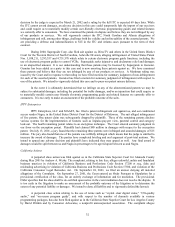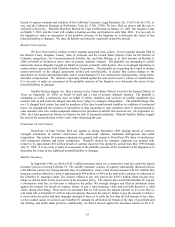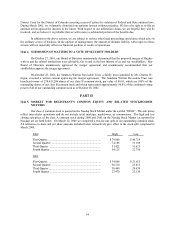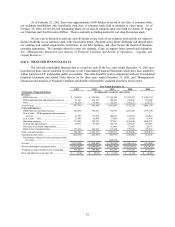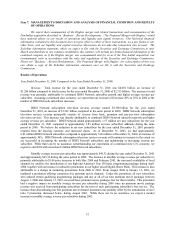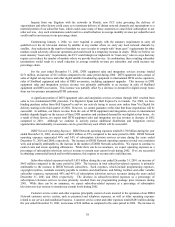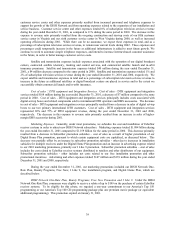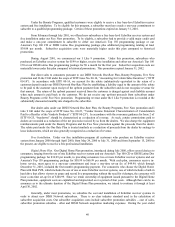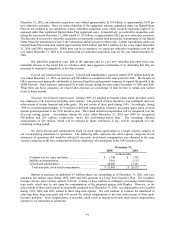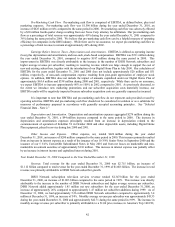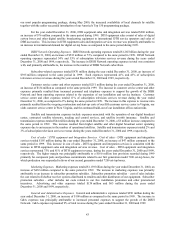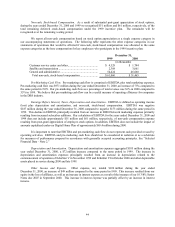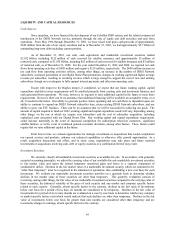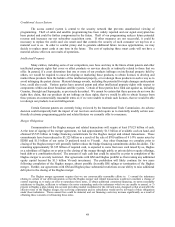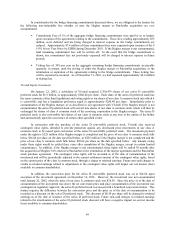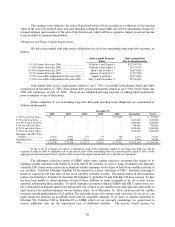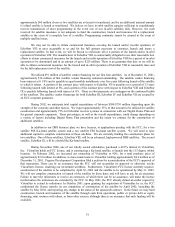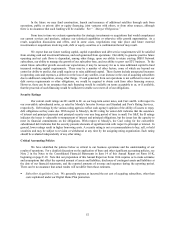Dish Network 2001 Annual Report Download - page 44
Download and view the complete annual report
Please find page 44 of the 2001 Dish Network annual report below. You can navigate through the pages in the report by either clicking on the pages listed below, or by using the keyword search tool below to find specific information within the annual report.42
Pre-Marketing Cash Flow. Pre-marketing cash flow is comprised of EBITDA, as defined below, plus total
marketing expenses. Pre-marketing cash flow was $1.596 billion during the year ended December 31, 2001, an
increase of $625 million or 64% compared to the same period in 2000. Pre-marketing cash flow was adversely effected
by a $30 million fourth quarter charge resulting from our News Corp. attorney fee arbitration. Our pre-marketing cash
flow as a percentage of total revenue was approximately 40% during the year ended December 31, 2001 compared to
36% during the same period in 2000. We believe that pre-marketing cash flow can be a helpful measure of operating
efficiency for companies in the DBS industry. While there can be no assurance, we expect pre-marketing cash flow as
a percentage of total revenue to remain at approximately 40% during 2002.
Earnings Before Interest, Taxes, Depreciation and Amortization. EBITDA is defined as operating income
(loss) plus depreciation and amortization, and non-cash, stock-based compensation. EBITDA was $511 million during
the year ended December 31, 2001, compared to negative $187 million during the same period in 2000. This
improvement in EBITDA was directly attributable to the increase in the number of DISH Network subscribers and
higher average revenue per subscriber, resulting in recurring revenue which was large enough to support the cost of
new and existing subscribers, together with the introduction of our Digital Home Plan in July 2000. Our calculation of
EBITDA for the years ended December 31, 2001 and 2000 does not include approximately $20 million and $51
million, respectively, of non-cash compensation expense resulting from post-grant appreciation of employee stock
options. In addition, EBITDA does not include the impact of amounts capitalized under our Digital Home Plan of
approximately $65.4 million and $338 million during 2000 and 2001, respectively. While there can be no assurance,
we expect EBITDA to increase approximately 80% to 100% in 2002 compared to 2001. As previously discussed, to
the extent we introduce new marketing promotions and our subscriber acquisition costs materially increase, our
EBITDA results will be negatively impacted because subscriber acquisition costs are generally expensed as incurred.
It is important to note that EBITDA and pre-marketing cash flow do not represent cash provided or used by
operating activities. EBITDA and pre-marketing cash flow should not be considered in isolation or as a substitute for
measures of performance prepared in accordance with generally accepted accounting principles. See “Selected
Financial Data – Note 2.”
Depreciation and Amortization. Depreciation and amortization expenses aggregated $279 million during the
year ended December 31, 2001, a $94 million increase compared to the same period in 2000. The increase in
depreciation and amortization expenses principally resulted from an increase in depreciation related to the
commencement of operation of EchoStar VI in October 2000 and other depreciable assets, including Digital Home
Plan equipment, placed in service during late 2000 and 2001.
Other Income and Expense. Other expense, net, totaled $426 million during the year ended
December 31, 2001, an increase of $200 million compared to the same period in 2000. This increase primarily resulted
from an increase in interest expense as a result of the issuance of our 10 3/8% Senior Notes in September 2000 and the
issuance of our 5 3/4% Convertible Subordinated Notes in May 2001 and from net losses on marketable and non-
marketable investment securities of approximately $110 million. This increase in interest expense was partially offset
by an increase in interest income and capitalized interest during 2001.
Year Ended December 31, 2000 Compared to the Year Ended December 31, 1999.
Revenue. Total revenue for the year ended December 31, 2000 was $2.715 billion, an increase of
$1.112 billion compared to total revenue for the year ended December 31, 1999 of $1.603 billion. The increase in total
revenue was primarily attributable to DISH Network subscriber growth.
DISH Network subscription television services revenue totaled $2.347 billion for the year ended
December 31, 2000, an increase of $1.003 billion compared to the same period in 1999. This increase was directly
attributable to the increase in the number of DISH Network subscribers and higher average revenue per subscriber.
DISH Network added approximately 1.85 million net new subscribers for the year ended December 31, 2000, an
increase of approximately 26% compared to approximately 1.47 million net subscriber additions during 1999. As of
December 31, 2000, we had approximately 5.26 million DISH Network subscribers compared to approximately 3.4
million at December 31, 1999, an increase of 54%. Monthly average revenue per subscriber was approximately $45.33
during the year ended December 31, 2000 and approximately $42.71 during the same period in 1999. The increase in
monthly average revenue per subscriber is primarily attributable to a $1.00 price increase in America’s Top 100 CD,


